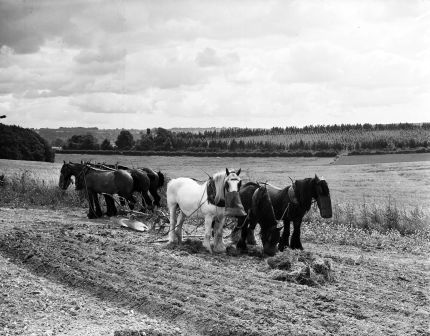As you will have read from Greta’s post Crowdsourcing with the Bucklebury History Group, we’ve been doing a lot of work over the past couple of weeks on our MERL Historypin channel. A large number of the Collier photographs of Bucklebury have been re-pinned to more precise locations, and some of them are even pinned to street-view, where possible. The next stage for us was to start to make proper use of some of the other features of Historypin, so Danielle and I spent an afternoon this week experimenting with ‘Tours’ and ‘Collections’.

A Collier photograph of Bucklebury ford, recently re-pinned to street-view.
Tours and Collections are essentially features that enable users to group together and highlight particular sets of ‘pins’, according to whatever theme they choose. The Collections feature is particularly suited to grouping pins by theme. A Collection could be created to show a set of photographs taken by a particular photographer, or a set of similar objects. The user can add some introductory text to explain the rationale of the collection and any other information they want to include. The selected pins can then be viewed either in list-form or as a slideshow.
The ‘Tour’ feature initially appears to be similar, but its potential lies in the use of pins that are pinned to street-view. Where relevant, the pins appear in the slideshow automatically in street-view, with a small map showing their location and a small space for extra text to its left. If all the pins are on street-view, then, a tour can enable the user to virtually ‘walk’ down a street, fading pins in and out of view and following their progress on a map.
Describing the features doesn’t quite convey their potential to enhance a Historypin channel, so the best thing to do would be to take a look at some of the tours and collections Danielle and I created this week, on the MERL and Bucklebury History Group channels. Simply go to the channels and select the ‘Collections’ or ‘Tours’ tabs.

The ‘George Lailey, Bucklebury Craftsman’ collection, on the MERL Historypin channel.
The ‘History Walk around Bucklebury’ tour on the Bucklebury History Group channel is a particularly good example of what these features can do. You’ll see that the tour includes photographs and objects pinned by MERL as well as those pinned by the History Group. In this way, users are not confined to their own content, but can make use of any photographs and objects pinned on the website.

A Collier photograph of Bucklebury pinned to street-view, as seen in the ‘Bucklebury History Walk’ tour.
And there are a lot of pins to choose from. According to the counter on the homepage, there are, to date, over 210,000 pins and comments on Historypin, and this can sometimes make the website (and individual channels) a victim of its own success. The more that is pinned the better, but this makes it harder to sift through the content to find particular images. If you look at the main list of pins on the MERL channel, for example, you will have to trawl through a lot of pages of object pins before you reach the Collier photo pins, which were added at an earlier date. A major benefit of the tours and collections features is that they provide solutions to this problem. They can highlight particular sub-sets of pins and make it much easier for their users to find what they might be looking for. We think they also make the channel more interactive, informative and enjoyable to browse.











